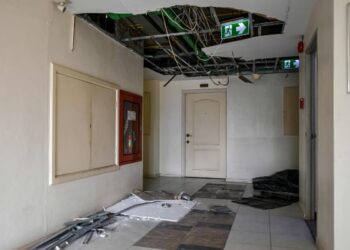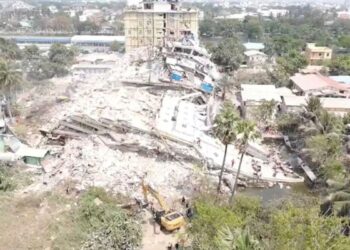- Isolated junta leader may gain credibility from Thailand visit.
- Reported death toll from 7.7 magnitude earthquake surpasses 3,000, according to CCTV.
- Relief groups report hospitals are overwhelmed and medications are lacking.
Min Aung Hlaing, Myanmar’s isolated leader, is set to depart his disaster-stricken country Thursday for an infrequent trip to a regional summit, as humanitarian organizations urged for the easing of restrictions to aid survivors from a catastrophic earthquake.
The 7.7 magnitude earthquake, among the strongest in Myanmar in a century, shook a region populated by 28 million, damaging buildings, demolishing communities, and leaving many without food, water, or shelter. According to China’s state media, the official death toll has exceeded 3,000.
The military junta has struggled since regaining power in a 2021 coup that ousted the elected government led by Nobel laureate Aung San Suu Kyi. Following the takeover, the generals have faced international isolation, leading to severe deterioration of Myanmar’s economy and essential services, including healthcare, amid ongoing civil conflict.
On Wednesday night, state-run MRTV announced a 20-day unilateral ceasefire to support recovery efforts following the earthquake, while cautioning that they would “respond accordingly” if rebels initiated attacks.
MRTV confirmed that Min Aung Hlaing would travel to Bangkok for a summit with mostly South Asian nations—an unusual trip for a general seen as a pariah by many countries, who faces Western sanctions and an investigation by the International Criminal Court.
The junta leader has also been barred from ASEAN summit participation.
Nevertheless, some analysts believe the earthquake and the upcoming summit, which includes leaders from Thailand, India, and Bangladesh, could enhance Min Aung Hlaing’s legitimacy as he moves forward with a largely criticized election in December that is expected to extend military rule.
Humanitarian agencies reported extensive destruction and a medical emergency in central Myanmar, with hospitals overwhelmed and medications in short supply, alongside a rising threat of waterborne diseases.
Mohamed Riyas, the Myanmar Director of the International Rescue Committee, described the humanitarian situation as “overwhelming.” He stated, “It may take weeks to fully comprehend the extent of the destruction caused by this earthquake due to downed communication networks and disrupted transport.”
“People are in urgent need of medical assistance, clean water, tents, food, and other essentials. Providing life-saving health services is critical,” he added.
Mikhael De Souza, a medical aid coordinator for MSF, mentioned that in Mandalay, the second-largest city, around 500 structures had completely collapsed, with an additional 800 sustaining partial damage.
“Many individuals are still forced to live outdoors in deplorable conditions,” he noted. “The lack of safe drinking water poses significant survival challenges.”
Military Readiness
Human rights organizations have accused the junta of hindering humanitarian efforts by enforcing strict security measures in several severely affected quake regions.
An incident highlighting the complications of delivering aid amid civil conflict occurred when junta troops reportedly fired warning shots at a Chinese Red Cross convoy that failed to stop in a conflict zone.
Junta spokesperson Zaw Min Tun remarked that the group had neglected to inform the authorities of its movements.
China was one of the first countries to provide assistance to Myanmar, sending rescue teams the day after the disaster and committing to 100 million yuan (about $13.76 million) in supplies.
A spokesperson for China’s foreign ministry indicated that the aid team and supplies were safe and urged all parties in Myanmar to guarantee the safety of rescuers and maintain clear relief routes.
Despite the nation facing its worst disaster in decades, the military has remained on high alert, conducting airstrikes and other operations near the affected areas, according to reports from rebel groups and Amnesty International.
Min Aung Hlaing stated that the military had ceased offensives but warned that rebels were preparing to exploit the disaster for potential attacks. A key rebel alliance announced a unilateral ceasefire earlier this week to facilitate humanitarian efforts.
Before the military’s declaration of a temporary ceasefire, Tom Andrews, the UN special rapporteur on Myanmar, condemned the junta’s post-quake assaults as “outrageous” and called for global leaders to denounce these actions vehemently.
Presence of Soldiers
Acquiring accurate information from areas like Sagaing has long been challenging due to a junta-imposed internet and cellphone blackout related to the ongoing conflict, which activists have urged be lifted following the earthquake.
The military has declined requests from international journalists to cover the earthquake’s aftermath, citing a lack of water, electricity, and accommodations.
“Soldiers are present throughout the town,” a man who visited Sagaing, close to the quake’s epicenter, told Reuters. “They are there for security rather than rescue operations, and they inspect every vehicle.”
Human Rights Watch, based in New York, urged the junta to permit unrestricted access to humanitarian aid and lift barriers affecting aid organizations, urging donors to channel assistance through independent entities rather than solely through junta authorities.
“Myanmar’s junta cannot be trusted to respond to a disaster of this magnitude,” stated Bryony Lau, HRW’s deputy Asia director. She implored agencies to pressure the junta to “provide full and immediate access to survivors, no matter where they are.”
A woman in Mandalay reported to Reuters that authorities were busy preparing a stage for this month’s Thingyan water festival, despite many individuals being homeless and corpses lying beneath collapsed buildings.
In Thailand, the death toll from the earthquake had risen to 22 by Wednesday, with search efforts continuing for survivors beneath the rubble of a skyscraper under construction in Bangkok, which has now entered its fifth day.
Heavy machinery was utilized to dismantle 100 tons of concrete in hopes of discovering a survivor amid the heap, where 15 individuals were confirmed dead, and 72 remain missing.
“We are continuing our search for survivors, but we are modifying our approach,” stated Bangkok Governor Chadchart Sittipunt. “We are creating a path for the rescue team to access the area.”






